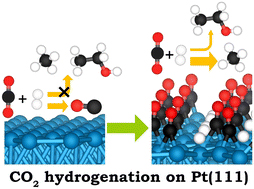Abstract
Hydrogenation of CO2 to ethanol is a promising process among various CO2 valorization processes. However, this process is challenging due to the difficulty of steering the hydrogenation reaction towards C-C coupling while suppressing side reactions such as methane formation. In the present study, we performed a comprehensive mechanistic study of thermocatalytic CO2 hydrogenation to CH3CH2OH on Pt(111) and the competing pathways involving the formation of CH4 and CH3OH, revealing the critical role of CO surface coverage in affecting the reaction energy profiles. The otherwise infeasible production of CH4 and CH3CH2OH on Pt(111) is enabled by the adsorbed CO, generated during the hydrogenation of CO2. The calculated energy profiles on pristine Pt(111) suggest that the coverage of CO and atomic hydrogen will increase when the reaction proceeds, with CO being the dominant adsorbate. The equilibrium coverage can be reached when the coadsorption free energy of CO and H is maximized. The adsorption of CO on Pt(111) makes the coadsorbed H relatively positively charged, which is favorable for the H-assisted dehydroxylation of CHOH that produces CH, a key intermediate for the formation of CH3CH2OH via CH-CO coupling or CH4 through subsequent hydrogenation steps. The CH-CO coupling and CH hydrogenation are also facilitated by the increase of CO coverage. Importantly, the increased reaction exothermicity and the more delocalized electronic state of the CO carbon atom are responsible for the decrease of the CH-CO coupling energy barrier. At the equilibrium of coverage of CO and H on Pt(111), microkinetic modeling reveals that while CH4 is the dominant product, the selectivity to CH3CH2OH can be notably increased by strengthening the adsorption of CO. Our study reveals the multiple aspects of the CO coverage effect on CO2 hydrogenation, enriching the knowledge of CO2 hydrogenation to C1 and C2 products.

Keywords Plus:HIGHER ALCOHOL SYNTHESISFINDING SADDLE-POINTSADSORPTION ENERGIESAB-INITIOETHANOLSELECTIVITYMECHANISMWATERGASEFFICIENCY
Published in CATALYSIS SCIENCE & TECHNOLOGY,Volume13,10.1039/d3cy01134h;OCT 30 2023


